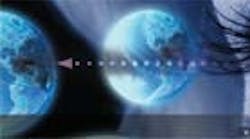Most products are shipped at one point or another, so must be securely contained to prevent breakage, spillage, and contamination. Sensors on packaging lines confirm that these boxes, bottles, and bags are properly sealed, labeled, and filled before leaving the manufacturing plant.
However, increasingly varied packaging of clear, translucent, or shiny glass and plastic containers, so common for beverages and pharmaceuticals, can give traditional photoelectrics trouble.
Other sensors have adapted to efficiently verify labeling and packaging, no matter its opacity. To put these sensors to work, operators no longer need to learn complex programming methods or use a laptop or remotely located PC to design an inspection. In addition, during inspection, operators can view online products in realtime, and access commands and tools to modify inspection onsite when needed.
Clearly challenging
A clear object is difficult to detect specifically because there is low contrast between it and its background. More sensitive photo eyes or photoelectric sensor models can be “taught” to detect very minute variances in contrast, and so are used here.
These sensors include a light emitter and receiver, and detect objects when they block, transmit, or reflects the sensor's emitted light. The greater the contrast (in other words, the ratio of light reaching the receiver in a light state versus a dark state) the easier it is for the sensor to detect an object.
Another effective solution is the retroreflective photoelectric sensor, in which emitter and receiver are contained in one housing, and the emitted beam is directed at a reflector opposite of the sensor. In this arrangement, the sensor is set to look for contrast differences down to a single-digit percentile, so that as a clear bottle is conveyed down a packaging line and breaks the light beam, the bottle appears as a “dark” condition and activates the sensor.
Shiny and glowing product
Other sensors detect clear objects by identifying luminescence — cold light emitted due to a chemical reaction that results from the absorption of radiant energy — in materials such as adhesives.
Luminescence sensors detect invisible light sources or glow, such as UV light, and responds by emitting visible light. The sensor's receiver then sends output to the application control system to identify whether a package is missing necessary adhesive and, if so, signal that it should be removed from the line.
In some cases, luminophores (in UV inks and marking equipment) are added to materials to make them easier to detect in this way. For example, clear plastic child or tamper-proofing rings on medicine bottles are sometimes infused with luminophores. Then luminescence sensors efficiently detect whether rings are present, to ensure proper sealing.
When package designs involve shiny or irregular surfaces such as Mylar, shrink-wrap or high-gloss materials, the target object may be too challenging for a traditional sensor to identify directly.
Instead, a foreground suppression sensor can indirectly detect these objects by using light reflected from a static background as a reference point — thus “suppressing” the high-gloss package in the foreground. Then as the package passes the sensor on the line, it reflects the sensor's emitted light from a different angle than the static reference point. This reflection triggers an output and identifies it as a detected object, allowing the sensor to reliably detect shiny packages.
Alternatives for sensing
Sometimes the heat associated already with a process is used for sensing. Consider hot glue sealing. Here, temperature sensors are more appropriate than other options for detecting semi-opaque adhesives. The sensors ensure that glue (warm from recent application) is present before packages are sealed, to combine the ease of photo sensing with the intelligence of a more sophisticated sensor — even activating when they detect that an object that is either hotter or colder than the ambient condition, for example.
Rather that detecting sensor-emitted light, as with photoelectric sensors, temperature sensors detect the infrared light energy emitted by objects. A thermopile serves as the receiver element (which consists of several thermocouple junctions and acting as a thermometer) that detects infrared energy in its field of view; the collected information is then measured and analyzed by an ASIC, and the sensor generates an output corresponding to the thermal contrast between the target object and its surroundings.
This output may then be used to verify and inspect control processes. In packaging applications, if a temperature sensor does not detect the glue necessary for sealing, the package is rejected from the line.
For more information, call (888) 373-6767 or visit www.bannerengineering.com.
Setup in two ways
Even though some new sensors can be set up without external hardware, some manufacturers still include PC connectivity. Often, results and configurations can be downloaded to a USB drive to be stored and referenced on a PC. (USB ports on sensors can also be used to upload new configurations.) Here, users setup new inspection parameters offline using the sensor's software emulator, then upload them to the sensor through the USB.
Aside from detecting the package itself, label detection and verification are key to ensuring proper packaging. Image sensing is often used to confirm proper label placement and orientation. Following the trend of consumer goods, touchscreen image sensors now allow users to setup and configure inspections right on the plant floor.
First, users acquire an image of a “good” part — a container with a properly affixed label — with which to compare all other products inspected. Then, the user can configure the sensor to look for a match. Upon acquiring the image, the image sensor makes a determination: Products correctly labeled pass inspection, while improperly labeled items fail and are rejected from the line.
The same technology can prove particularly useful for verifying date and lot codes on pharmaceutical products, both for tracking and to prevent counterfeits.




